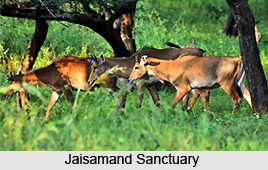 Jaisamand Sanctuary is a wildlife sanctuary in Rajasthan, located at a distance of 51 km south east of Udaipur and spread over an area of 160 square kilometres.
Jaisamand Sanctuary is a wildlife sanctuary in Rajasthan, located at a distance of 51 km south east of Udaipur and spread over an area of 160 square kilometres.
Jaisamand Sanctuary is the home of countless species which include sloth bear, leopard, chital, chinkara and wild boar. In this wildlife sanctuary of Udaipur of Rajasthan, there are large number of the birds breed here such as darter, open bill stork, pond heron, little cormorant and Indian Shag. The aquatic life is also found in the lake of Jaisamand Sanctuary such as the fish and the crocodiles. The lake of Jaisamand Sanctuary is known as Jaisamand Lake or Dhevar Lake.
Jaisamand Lake is one of the elite sites of Udaipur district of Rajasthan. The lake was one of world`s largest artificial lakes till the Aswam dam was built in Egypt. The lake stretches 9 kms in breath and is 102 feet deep with a circumference of 30 miles with some exclusive marble staircases that descend in the water.
Jaisamand Lake in Jaisamand Sanctuary is also known for the island attractions. There are seven islands on the lake and the tribe of Bhil Minas inhabit these islands. There are two main islands which are large in size. The biggest island is called Babaka Bhagra while the smallest is called "Piari".
The historical legend of Rajputana shows that Rana Jai Singh constructed the Dhebar Lake or Jaisamand Lake to provide a perfect backdrop for a summer retreat. On the dam near the Jaisamand Sanctuary are the six exotic cenotaphs and a Lord Shiva temple in the centre. The northern end of the lake has a palace with a courtyard while its southern end has a pavilion of 12 pillars. The hills to its south have grand palaces that have an excellent view of the lake.
The forests around Jaisamand Lake, which is known as Jaisamand Sanctuary was once the hunting grounds for the local and British rulers. It was also the hunting ground of Maharanas of Mewar, have now been converted into a game sanctuary of Jaisamand.
Jaisamand Sanctuary built in 1957 lies just beside the artificial Jaisamand Lake and has an area of 62sq km. The lake welcomes a wide variety of resident and migratory birds and is also home to the crocodiles. Jaisamand Wildlife sanctuary is a home for different species of animals like Panther, Wild Boar, Deer, Antelopes and mongoose etc. The leopard, hyena, jungle cat, fox and wolf are among the carnivores of the sanctuary. The surrounding forest is infested with leopard, cheetal (spotted deer) and chinkara (Indian Gazelle).
The Jaisamand Lake in Jaisamand Sanctuary is the dwelling place for crocodiles, turtles and a variety of fish.
Jaisamand Sanctuary of Rajasthan is the perfect option for the nature lovers and the wildlife explores who want to see the species in their totally natural atmosphere. There is another sanctuary which located in the vicinity of Jaisamand sanctuary and stretches over an area of 45 kilometres and has a road through which the motors could be driven.











